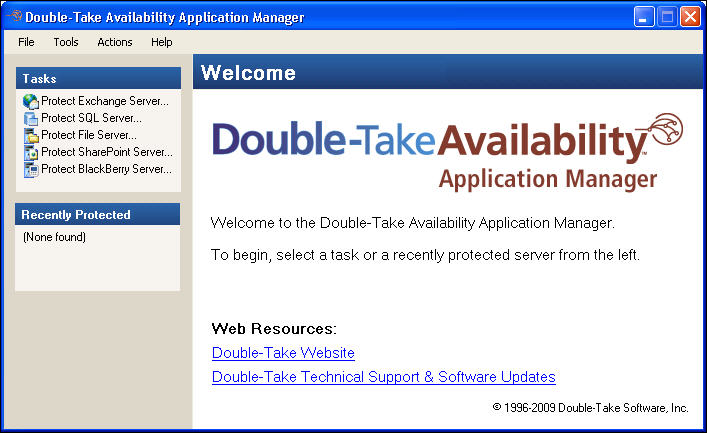
Launch the Double-Take Availability Application Manager by selectingStart, Programs, Double-Take, Availability, Double-Take Availability Application Manager.
If you have not yet set up protection, the window will show the Welcome screen.
|
|
When you select an application to protect in the Tasks area on the left pane, you will enter an application protection workflow.
The Setup tab of the Application Manager window leads you through the steps to configure protection for a server using standard Windows-style controls. Enter information in fields, select options from drop-down menus, click buttons, and use menu options to configure protection.
After protection has been set up, use the Monitor tab to view information about the current source/target pair. Based on the current protection status and/or failover state, the Failover, Monitoring, and Protection button text on the Monitor tab will be updated to display the available command. If the Application Manager is not in a state that will allow any of these options to be executed, the corresponding button(s) will be grayed out (disabled).
You can launch the Double-Take Availability Application Manager from the command line to open it in the following contexts:
dtam /exchange— Launches the Application Manager in the Exchange context
dtam /sql —Launches the Application Manager in the SQL context
dtam /sharepoint—Launches the Application Manager in the SharePoint context
dtam /fileprint— Launches the Application Manager in the File server context
dtam /blackberry— Launches the Application Manager in the BlackBerry context
dtam /<application> /advanced— Launches the Application Manager with Advanced options available. Advanced options allow you to control what functions Application Manager will perform during configuration; however, they are intended to be used by only advanced users. Individual functions should only be disabled for testing or debugging purposes. Valid application switches are /exchange, /sql, /sharepoint, /fileprint, and /blackberry.
| Note: | The Application Manager is not localized for non-English operating systems. |